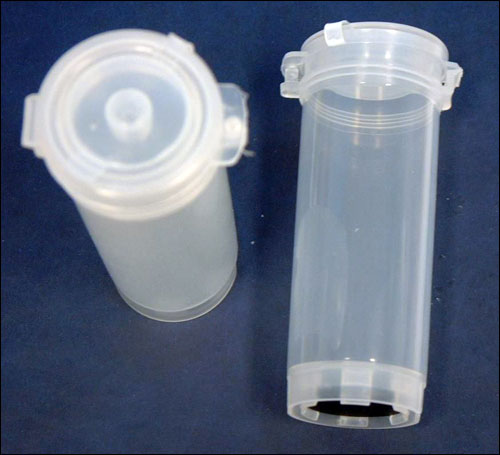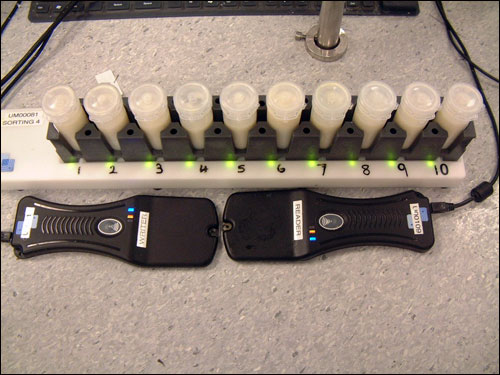Jun 01, 2010SAITL Dairy Laboratory, a New Zealand company that conducts biological and chemical tests on milk samples for quality analysis, has been employing radio frequency identification to automate the identification of batches and samples, thereby increasing the speed and accuracy of identification, minimizing manual handling, reducing errors and improving traceability.
Margaret Malloch, the Hamilton-based firm's general manager, says the laboratory receives up to 20,000 to 30,000 plastic cylindrical vials of milk from dairy factories every day. But the previous system of identification, which included bar codes and manual checking, was no longer suitable for SAITL's needs, she adds, as it was too time-consuming and prone to human error.
"RFID fitted in with our planned automation of the laboratory, so we set up a project to review how best to implement the new system and the changes required," Malloch explains. "But we also needed to develop a process for writing information from bar codes to the RFID tag for some customers, so they could still be processed via the same system."
A laboratory is a challenging environment in which to introduce RFID. Due to the samples' close proximity to one another, and the large amount of metal in many instruments, SAITL spent considerable time making sure the RFID antenna and readers were tuned correctly, to ensure accurate and precise readings. Another challenge was the lack of a human-readable interface on the new tags. The bar-coded labels that the firm had been utilizing included human-readable text, but if the labels were replaced by a passive 13.56 MHz RFID tag attached to each vial's exterior bottom, technicians might find it difficult to locate and identify a specific sample.
"This led to a requirement for a customized large antenna and reader software to cope with reading multiple tags in a small time frame," Malloch states.
At SAITL's lab, workers initially load milk-filled vials onto trays, and then pass them over a bank of RFID readers, arranged in three rows, each with 10 interrogators. A single tray can hold 250 vials, and having 30 readers provides rapid reading of the vials' tags, which comply with the ISO 15693 standard and are capable of storing 250 bytes of data. The tag data is sent to SAITL's database, which returns information detailing the specific tests each sample must undergo. This ensures each sample is subjected to the appropriate biological and chemical testing, to guarantee the milk's quality and safety before Fonterra bottles it for sale to consumers, or uses it to make cheese, ice cream or other dairy products. SAITL has a number of different RFID readers and writers for various applications within the lab. Most are customized solutions developed by Tracient to address the unique problems SAITL faced. For example, one testing instrument could accommodate an ID number no larger than 20 digits, whereas the Fonterra ID is 57 characters, so the reader was modified to reduce the 57 digits down to 20. Laboratory employees also use off-the-shelf Tracient handheld readers to manually read some vial tags.
Fonterra, which installed the system for SAITL, had already been involved in the Milk Collection Programme of Work (MCPOW), of which the SAITL project is now a part, In January 2006, Fonterra Milk Supply formally launched MCPOW, which uses RFID to track milk collection from the farm to the factory. When Fonterra collects milk stored in vats at dairy farms, RFID reader-writers on milk tanker trucks automatically read information encoded to the RFID tag attached to each vat. Every vat is fitted with one of TI's DS105 RFID tags, and encoded with such information as the company ID, the farm ID, the milk temperature, the volume collected, and the date and time collected, along with a status code.
For SAITL's implementation, custom RFID antennas are connected to Tracient readers to communicate information to a centralized database, either via mobile data transmission or standard synchronization tools, upon return to base. Tracient also helped to produce the customized readers required to overcome the unique conditions within the lab, including the high quantity of metal and the tags' close proximity to each other. The software used by SAITL to manage the data is called MADCAP (Milk Analysis Data Capture and Processing), and was provided by the Contec Group.
The readers and writers used in the overall Milk Collection Programme of Work run by Fonterra—which now includes SAITL—range from handheld readers to interrogators on tankers used to transport milk from farms to factories to in-lab readers at SAITL. These devices number in the thousands. More than 14,000 vats used to store milk at Fonterra's factories are also tagged by Fonterra throughout New Zealand, meaning the company can use the information on the tag to identify the farm from which milk in a particular vat or tanker originated, while also recording the collection volume, and the sample's temperature at the point of collection. Overall, more than 600,000 tags are in use as part of the project.
She adds, "For our customers still using bar codes [on the sample vials], we write the information from the bar code to the RFID tag on the sample vial, and then process the sample. Once testing is complete, the identification information on the tags is erased, the tags are released from the sample vial and the vials are returned to the plastic manufacturer for re-use. Indications are that 100,000 uses will be obtained from each tag."
Recycling the plastic from the sample vials is an additional income stream for SAITL, and is one of the many benefits derived since RFID was introduced. Previously, sample vials were composed of two different plastics, and recycling was deemed impractical, but the new vial used in milk collection can now be recycled. According to Malloch, the introduction of RFID has resulted in improved speed of processing samples, as 150 vials can be read with a single pass over an RFID reader. RFID has also improved accuracy in sample identification, and in determining which tests are required for each sample, enhancing productivity and reducing cost. Moreover, there has been a reduction in errors in determining which tests are required for each sample, thereby decreasing the need for monitoring and corrections. RFID also ensures greater traceability of milk samples from the farm to the lab, as each sample can be identified at every point along the supply chain.
While RFID was brought in as part of the plant's overall automation, and although specific cost savings are hard to quantify, Malloch says efficiencies at the laboratory have clearly improved. Currently, she says, there are no plans to expand the system, though given the success of RFID and automation at the lab, that possibility is always under review.



